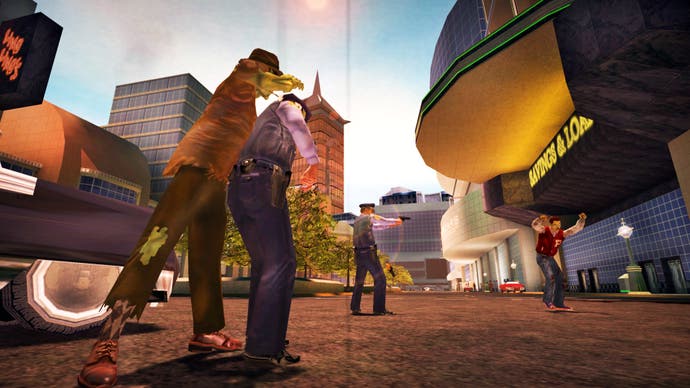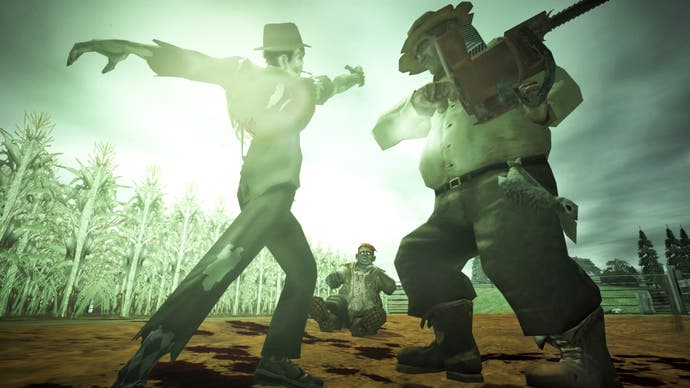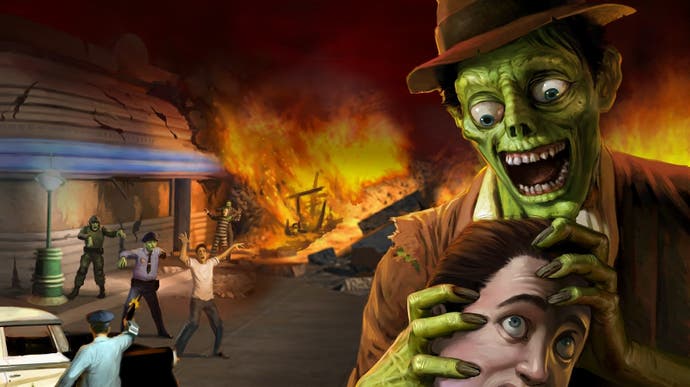Stubbs the Zombie is an uncanny classic
Silencio.
How quickly when you're thinking about Halo does the music come into your head? I'm imagining it's probably there before the first images. Mournful, ancient, righteous, heroic, the music in Halo is doing an awful lot. It's been described in interviews as the thing that makes everything else twice as good, and it's hard not to suspect that's true. Get in a Warthog and the camera moves back and that music starts up: let's get on with it.
Leaving that for just a second, it must be annoying having been part of the team that made the original Halo. Annoying in a way that being in the Beatles must be annoying. Whatever you do next, you know where the comparisons are going to lie. Even when you take a very different tack, like Alex Seropian, for example, who ditched the Master Chief for Stubbs the Zombie, a fascinating curio that has finally made the transition to modern machines, with a port that I've been playing on Switch the last few days. There's a lot to think about with Stubbs, but inevitably Halo comes into it quite often - and not just Halo, but Halo's music.

I remember playing Stubbs very briefly back when it came out in - jeepers - 2005. My take at the time, and it was hardly original, was that here was a game in which you played as the Flood rather than the Chief. Stubbs uses the Halo engine to conjure one of those atomic utopian hellholes the 1950s were so good at imagining. Punchbowl is the ultimate futuristic town for the decade of Doris Day and Reds in the Bed. It has its own monorail! People are doing weird things with agriculture! You get shown around by a robot! And the police force is gigantic and militarised.
Into this world comes Stubbs, dressed like a Jack Lemmon travelling salesman, down to the sagging suit and wearily angled hat, and already a zombie by the time things kick off. Stubbs is taking a very personal approach to the American Dream. He wants to eat everyone's brain. Doing this switches former enemies onto his side - they become zombies too. It's an ingenious mechanic and it does feel at times like the Flood are rampaging once again. Stubbs has other tricks too: he can bowl his head because the 50s were very big on bowling. He can throw his internal organs like Halo grenades. He can rip off his arm and let it scamper about like Thing from the Addam's Family, great for exploring vents and possessing enemies in order to use their firearms. Stubbs is all set.
And we're all set too, for a knockabout and kinetic comedy of gleeful violence. Stubbs and us against the 1950s, against conformity and authority and the UNSC! It's a reminder that zombie films almost always used to have a political component - that you can't really invoke zombies without making a political point intentionally or otherwise. And if its sci-fi 50s seems over the top, it's worth remembering that anecdote from The Life and Times of the Thunderbolt Kid, Bill Bryson's memoir of growing up in the picket fence decade, in which he recalls reading a newspaper story about a plan to use rockets to deliver mail.
Playing now, though, the end result is so much weirder than all that. And so much more interesting. Aspyr's new port is one of those light-touch affairs. The game runs at a good clip, but nothing has really been changed. It's 2005 game design in amber. And that's fascinating by itself.

So you get just the kind of stop-start interminable tutorial that Halo, oddly, skipped. But beyond that you get these brilliantly massive 2005 levels, massive spaces and very loose objectives. Stubbs is a sandbox at times.
But here's the thing: it's a very uncanny sandbox. And I reckon it's uncanny because of the absence of music. Was Stubbs always so sparse with its soundtracking? I can't remember - and the few videos I watched of the original game suggest that maybe it was. But aside from scattered musical cues, an awful lot of Stubbs now - and perhaps back then - takes place with no music at all.
A reminder that Stubbs is an unusual game. You're playing what's traditionally a baddy, and you're going on a murderous rampage. The absence of music - of any emotional prompts from the developers to make sense of what's going on - leaves the whole thing kind of funny, but also weird and jarring and oddly challenging. It's like those clips of Ross from Friends without the laugh track. It's the howling void of Garfield Minus Garfield. You rock around, bowling your head, throwing your exploding pancreas, chewing through cops, and what you hear is their screams and a bit of dialogue and the keystone clatter of feat and truncheons. One level is a rampage through the centre of town and I swear it's just wind and sirens and comedy sound effects as you tear through your victims. It's a reminder of how often we're told how to feel by music, how often we're justified by it. Its absence here is almost brilliant.
The sheer scale of some levels feels like its own kind of silence, too. Broad avenues and wide parks and massive buildings - there is always a touch of doomy Halo scale to the buildings - and stretches of farmland. Sure, you get the ghosts of the Covenant whenever you see a sheer metal texture or a corridor lit by red lamps, but a lot of the time you feel something unique to Stubbs - isolation and, at a push, a kind of alienation. (And we're back to Jack Lemmon's travelling salesman.)
I love so much about this weird, jarring game. I love the horrible silences and the awkward comedy. I love Stubbs' Nosferatu pose as he jangles through each level, the best moments in the game putting you in darkness, turning you into this angular absence that looms out at your foes. Some of this strange brilliance is intentional, and I suspect some of it is the reality of making games in 2005 and of budgets and limitations and good ideas that didn't come off. Whatever it is, Stubbs is back, and despite the Halo links, there really is nothing quite like it.


